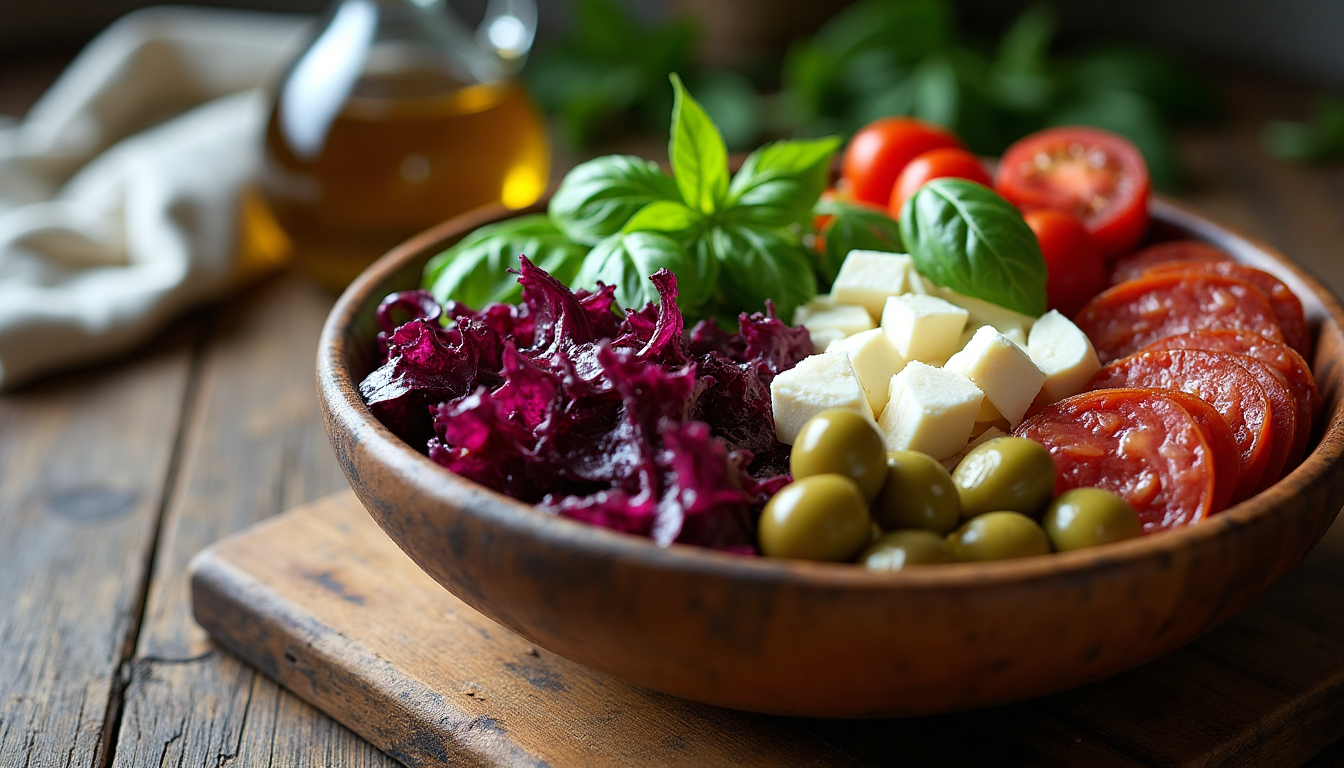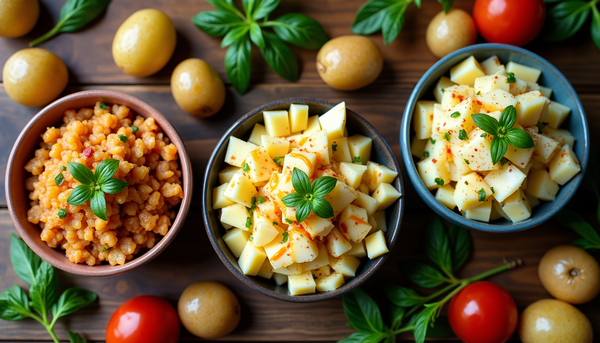Why Your Italian Chopped Salad Needs More Soul

Why Your Italian Chopped Salad Needs More Soul (And How My Nonna Would Fix Yours)
Ciao, beautiful people!
Let me tell you something that's been eating at me lately... I was scrolling through food blogs last week (occupational hazard, I know) and I saw yet another "authentic Italian chopped salad" that looked like it was assembled by someone who learned about Italy from a Pizza Hut commercial.
My nonna Rosa would've thrown her wooden spoon at the screen.
Look, I get it. We live in America, ingredients are different, our palates have evolved. But there's a difference between adaptation and... well, whatever the hell that was with the iceberg lettuce and ranch dressing masquerading as "Italian."
The Problem With Playing It Safe
Here's the thing that drives me absolutely nuts about most Italian chopped salad recipes floating around: they're scared of being too Italian. Everyone's so worried about alienating readers that they strip away everything that makes these salads special in the first place.
"Oh, radicchio might be too bitter." "Maybe we should use regular olives instead of the good stuff." "Do we really need that much garlic?"
YES. YES WE DO.
Growing up in Brooklyn with my nonna, I learned that Italian cooking isn't about making everyone happy – it's about making food with carattere. Character. Soul. The stuff that makes you close your eyes on the first bite and go "Madonna mia, that's good."
What Italy Actually Taught Me About Salads
Most people think Italian salads are just "throw some tomatoes and mozzarella together and call it a day." But spend time in different regions of Italy (or better yet, grow up with someone who did), and you'll quickly learn there's so much more nuance.
In Emilia-Romagna, my nonna's region, they understood that a proper salad is about contrasti – contrasts. Not just colors (though Instagram would have you believe that's all that matters), but flavors, textures, temperatures. Sharp against mild. Creamy against crisp. Salty against sweet.
The traditional "chopped salads" from places like Sicily or Calabria weren't just random vegetables tossed together. They were compositions. Each ingredient had a purpose, a role to play in the bigger symphony. The bitter radicchio cutting through rich salumi. The brine from good olives waking up your palate. The fresh herbs singing over everything else.
This is what we've lost in translation.
My Take: Chopped Salad With Actually Italian Soul
So here's how I make an Italian chopped salad that would get a nod of approval from nonna's ghost (may she rest in peace, but also probably still judging all our cooking from above).
The Foundation: Greens That Actually Do Something
First off – and I cannot stress this enough – you need the radicchio. Yes, it's bitter. That's the point! If you want bland, go make a Caesar salad with bagged lettuce. Radicchio di Treviso if you can find it (the long, elegant kind), but honestly, any radicchio will do.
Mix it 50/50 with romaine, but here's my trick: massage that radicchio first with a tiny bit of good olive oil and a pinch of salt. Thirty seconds of love with your hands, and it becomes silky instead of aggressively bitter. Nonna taught me this when I was maybe eight years old, standing on a step stool in her kitchen, complaining about "yucky purple leaves."
The Supporting Cast: Where Most People Go Wrong
Everyone gets so excited about the "fun" ingredients that they forget about building proper flavor foundation. Here's where I probably sound like a food snob, but honestly? Life's too short for bad olives.
Get yourself some Castelvetrano olives. Yes, they cost more than the black rubber rings from a can. Yes, they're worth it. They have this meaty, almost buttery quality that makes everything else in the salad better. Same goes for the pepperoncini – find the good Italian ones that still have some crunch and actual flavor, not the mushy yellow things that taste like vinegar water.
For salumi, I love a good soppressata or gabagool (that's capicola for you non-Italians), but honestly? Whatever Italian cured meat speaks to your heart. Just please, for the love of San Giuseppe, don't use regular deli ham and pretend it's the same thing.
The Cheese Situation: Where I Get Controversial
Okay, here's where I'm probably gonna lose some of you traditional purists, but hear me out. While fresh mozzarella is beautiful and classic, I actually prefer using a mix of two cheeses in my chopped salads.
Good quality fresh mozzarella? Absolutely. But I also add little cubes of aged provolone piccante. That sharp, slightly spicy bite plays so well against the mild mozzarella, and it holds up better to the dressing without getting soggy.
My cousin Tony from Jersey would probably disown me for this, but sometimes I even throw in some crumbled gorgonzola if I'm feeling fancy. Sue me – it's delicious.
The Dressing That Actually Deserves These Ingredients
Here's where most recipes totally phone it in. They give you some basic vinaigrette recipe like that's gonna cut it. But a proper Italian salad dressing needs to be almost aggressive in the best way.
I make mine with good red wine vinegar (not the stuff that's been sitting in your pantry since Obama was president), really good olive oil (I'm partial to Calabrian, but that's personal bias), minced garlic that I let sit in the acid for at least ten minutes to mellow out, a generous squeeze of anchovy paste (trust me on this), and a pinch of dried oregano that I crush between my palms to wake it up.
The ratio? Honestly, I never measure. Start with three parts oil to one part vinegar, taste, adjust. Add more acid if it feels flat, more oil if it's too sharp. Cook with your mouth, not just your measuring cups.
The Assembly: Where the Magic Actually Happens
This is where I see most people totally blow it. They chop everything into these perfect, uniform little cubes like they're preparing for some molecular gastronomy experiment. But that's not how you eat salad, is it?
Everything should be roughly the same size – I'm talking maybe ¾-inch pieces – but with some variation. You want some pieces of salumi that are a little bigger so you really taste them. Some cherry tomatoes that are halved, not quartered to death. Chunks of cheese that are substantial enough to be satisfying.
And for God's sake, toss it with your hands! Use tongs if you're serving guests and want to be civilized, but when it's just you and the family? Get in there. Mix it like you mean it. Taste as you go. Adjust the seasoning.
Let's Make This Personal: Your Turn
Here's what I want you to try this week: make this salad, but make it yours. Maybe your family has a connection to a different region of Italy. Maybe you've got some ingredients in your fridge that would work beautifully here.
My friend Sarah adds chickpeas because her Sicilian grandmother always did. My neighbor Joe throws in some roasted red peppers from his garden. My cousin Maria (the one who married the guy from Napoli) adds these tiny mozzarella balls that she gets from this place in the Bronx.
The point isn't to follow my recipe exactly – it's to understand why each ingredient is there, and then make choices that make sense for your kitchen, your family, your taste buds.
Questions for You (Because I Actually Want to Know)
What's your biggest challenge when making Italian food at home? Are you intimidated by ingredients you're not familiar with? Do you have trouble finding good Italian products where you live?
And honestly – what Italian dishes did you grow up eating that maybe weren't "authentic" but were authentic to YOUR family? Because here's a secret: that stuff matters too.
Food evolves. Recipes travel. Families adapt. The trick is knowing when you're honoring tradition and when you're just being lazy.
The Real Secret Ingredient
You know what makes any dish truly Italian, whether it's this salad or my nonna's ragu that simmers for six hours? It's giving a damn. It's caring enough to seek out good ingredients. It's taking the extra two minutes to toast your spices or massage your greens or let your garlic bloom in the oil.
It's understanding that food is never just about food – it's about taking care of the people you love, preserving memories, creating new ones.
So yeah, you could absolutely make this salad with bagged lettuce and bottled dressing and call it a day. And you know what? It would probably taste fine. But "fine" isn't what we're after here, is it?
We're after that moment when everyone at the table stops talking for a second because they're too busy actually tasting their food. We're after the kind of flavors that make you understand why people get emotional about regional Italian ingredients.
We're after salads with soul.
Buon appetito, friends. And remember – la vita è troppo breve per il cibo mediocre.
Life's too short for mediocre food.
What's your favorite Italian ingredient that most people are afraid to try? Drop a comment below – I read every single one and love hearing your stories!




